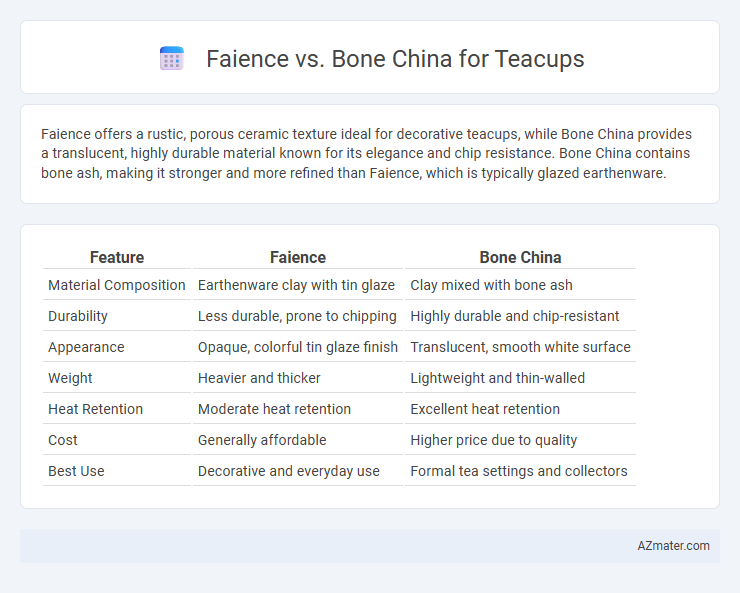Faience offers a rustic, porous ceramic texture ideal for decorative teacups, while Bone China provides a translucent, highly durable material known for its elegance and chip resistance. Bone China contains bone ash, making it stronger and more refined than Faience, which is typically glazed earthenware.
Table of Comparison
| Feature | Faience | Bone China |
|---|---|---|
| Material Composition | Earthenware clay with tin glaze | Clay mixed with bone ash |
| Durability | Less durable, prone to chipping | Highly durable and chip-resistant |
| Appearance | Opaque, colorful tin glaze finish | Translucent, smooth white surface |
| Weight | Heavier and thicker | Lightweight and thin-walled |
| Heat Retention | Moderate heat retention | Excellent heat retention |
| Cost | Generally affordable | Higher price due to quality |
| Best Use | Decorative and everyday use | Formal tea settings and collectors |
Introduction to Faience and Bone China
Faience is a type of glazed ceramic ware known for its vibrant colors and intricate designs, often produced with a tin-glazed finish that provides a glossy surface. Bone china, on the other hand, is a porcelain made with bone ash, feldspathic material, and kaolin, renowned for its high whiteness, translucency, and durability. Both materials are prized for teacups, with faience emphasizing decorative artistry and bone china valued for its refined elegance and strength.
Historical Background of Faience and Bone China
Faience originated in ancient Egypt and later flourished in Renaissance Europe, characterized by its tin-glazed earthenware that provided a vibrant, opaque surface ideal for decorative artistry. Bone China, developed in 18th-century England by Josiah Spode, introduced a revolutionary blend of bone ash, kaolin, and feldspar, resulting in a durable, translucent porcelain prized for its elegance and strength. Both materials reflect distinct technological advances and cultural influences, with faience emphasizing ornamental craftsmanship and bone china focusing on functional sophistication in teacup production.
Material Composition: Faience vs Bone China
Faience teacups are crafted from a porous earthenware clay, often coated with a tin glaze that gives them a distinctive opaque, glossy finish. Bone China, on the other hand, incorporates bone ash, kaolin, and feldspar, resulting in a highly durable, translucent material renowned for its whiteness and strength. The bone ash content in Bone China typically ranges from 25% to 50%, which enhances its chip resistance and delicate appearance compared to the more rustic, less vitrified composition of Faience.
Manufacturing Processes Compared
Faience teacups are crafted through a tin-glazing process on coarse earthenware, resulting in a porous and opaque body decorated with vibrant, hand-painted designs before firing at lower temperatures around 1000degC. Bone china, however, incorporates bone ash into a refined mixture of kaolin and feldspar, which is fired at higher temperatures near 1250degC, producing a translucent, durable, and chip-resistant ceramic ideal for fine teacups. The difference in firing temperatures and raw materials leads to bone china's superior strength and whiteness compared to the more rustic, colorful faience finish.
Appearance and Aesthetic Differences
Faience teacups feature a rustic, matte finish with vibrant hand-painted patterns, offering a charming, artisanal appeal that highlights traditional craftsmanship. In contrast, Bone China teacups boast a translucent, glossy surface with delicate, often intricate designs, exuding elegance and refinement suitable for formal settings. The difference in materials results in a heavier, sturdier feel for Faience, whereas Bone China is lighter and thinner, enhancing its sophisticated and delicate aesthetic.
Durability and Strength: Which Is Superior?
Faience and Bone China differ significantly in durability and strength for teacups, with Bone China generally considered superior due to its high levels of kaolin and bone ash that create a strong, yet lightweight material. Faience, made from earthenware clay, is more porous and prone to chipping or cracking under thermal stress. Bone China's resilience and translucent finish make it the preferred choice for long-lasting, elegant teacups.
Weight and Handling Experience
Faience teacups are generally heavier and thicker, providing a sturdy feel that enhances grip and durability during handling. Bone china teacups are significantly lighter and thinner, offering a delicate and refined tactile experience that many users find elegant and comfortable. The lightweight nature of bone china often results in less hand fatigue, making it ideal for extended tea sessions compared to the more substantial faience material.
Cost and Availability Analysis
Faience teacups are generally more affordable due to lower production costs and easier material sourcing, making them widely available in various designs and retail outlets. Bone china teacups, prized for their durability and translucent quality, often come at a higher price point because of the expensive bone ash used and the intricate manufacturing process, which can limit availability to specialty stores or premium brands. Cost-conscious buyers seeking everyday use may prefer faience, while collectors and enthusiasts willing to invest in longevity tend to favor bone china.
Suitability for Tea Drinking
Faience offers a rustic charm with its porous, glazed surface suitable for casual tea drinking but may absorb flavors over time, impacting taste purity. Bone china, crafted with bone ash, provides exceptional translucency, durability, and a non-porous surface, preserving the delicate aroma and temperature of tea, making it the preferred choice for refined tea experiences. For tea enthusiasts prioritizing flavor integrity and elegance, bone china's superior heat retention and smooth texture enhance both drinking comfort and aesthetic appeal.
Choosing Between Faience and Bone China
Choosing between faience and bone china for a teacup depends on durability, appearance, and cost considerations. Faience offers a rustic, colorful glaze with moderate strength, making it ideal for casual use and decorative purposes. Bone china, composed of bone ash, provides superior translucency, high chip resistance, and a refined elegance suitable for formal settings and lasting everyday use.

Infographic: Faience vs Bone China for Teacup
 azmater.com
azmater.com